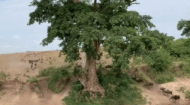|
|
|

amounts of water thus can mainly be found where water is always available throughout the year. They are capable swimmers and will often traverse rivers in search of better grazing. Buffalo herds vary in size from large savannah herds of 30-500 individuals living in a "range" of 26 to 1,075 square kilometres to much smaller forest herds of just 8-20 animals. Forest buffaloes are also smaller in size with reddish brown coats compared with the black or dark brown coats of the savannah buffalo. The buffalo herd will move in a circular manner around the range allowing for vegetation to regrow.
There are over a million buffalo in Africa with three quarters of them living in protected areas. As such, despite ongoing hunting, their survival is not a cause of concern unlike other members of Africa's Big Five club of animals. In fact they are much more susceptible to diseases such as Foot and Mouth (and, historically Rinderpest), than hunting either by humans or other mammals with only lions and crocodiles daring to take them on and then only in large numbers and when they think the buffalo is vulnerable. The African buffalo is a herbivore and lives mainly on grass and other green foodstuffs however if such nutrition isn't abundantly available, they lose their condition rapidly. They primarily graze at night and early morning to avoid the heat of the day. This behaviour has earned them the nickname "nature's lawnmowers" as they can quickly thin out dense grasses. As such, malnutrition is a major source of early death and they are rarely found living in areas with less than 10 inches of rainfall each year. The video (left) shows the African buffalo in its natural habitat. |



 The female buffalo normally has offspring every two years from the age of 4-5yrs with a gestation period of 11-12 months and the children, once born, remain dependent on their mother for almost a full year. Female calves tend to remain in the herd permanently, whilst the males often leave by the age of four.
The female buffalo normally has offspring every two years from the age of 4-5yrs with a gestation period of 11-12 months and the children, once born, remain dependent on their mother for almost a full year. Female calves tend to remain in the herd permanently, whilst the males often leave by the age of four.


